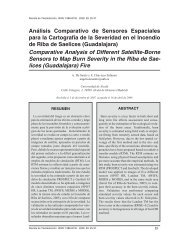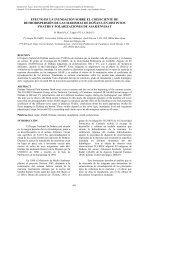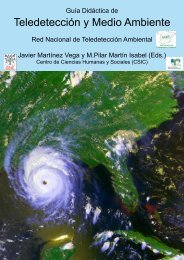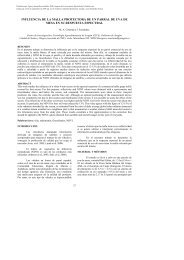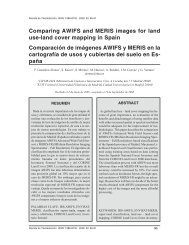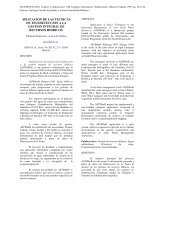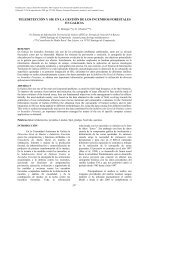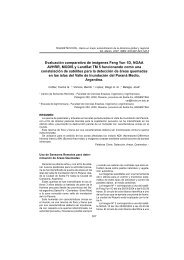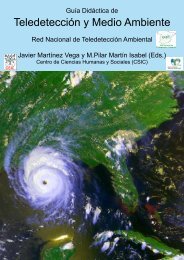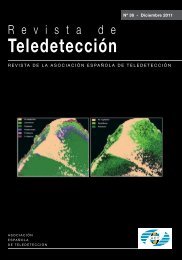M. R. Iglesias et al.INFOSTAT. 2008. Manual <strong>de</strong>l usuario. Grupo Infostat.Primera Edición. Editorial Brujas Argentinas.FCA. Universidad Nacional <strong>de</strong> Córdoba, Córdoba,Argentina. 334 pp.JOBBÁGY, E. G., SALA, O. E. & PARUELO, J. M.2002. Patterns and controls of primary productionin the Patagonian steppe: a remote sensing approach.Ecology, 83(2): 307-319.MCR HOLM, A., CRIDLAND, S. W. & RODERICK,M. L. 2003. The use of time-integrated NOAANDVI data and rainfall to assess landscape <strong>de</strong>gradationin the arid shrubland of Western Australia.Remote Sensing of Environment, 85: 145-158.NAGAI, S., ICHII K. & MORIMOTO, H. 2005. I<strong>de</strong>ntificationof the climate control factors on carboncycle variations of tropical forests combined analysisof ground and satellite observations. The 11 thCEReS International Symposium on Remote Sensing.Disponible en: http://www2.cr.chibau.jp/symp2005/documents/Postersession/p013_ShinNagai_paper.pdf. Julio 2010.NOY-MEIR, I. 1973. Desert ecosystem: environmentand producers. Annual Review of Ecology andSystematics, 5: 25-51.OGLE, K. & REYNOLDS, J. F. 2004. Plant responsesto precipitation in <strong>de</strong>sert ecosystems: integratingfunctional types, pulses, thresholds, and <strong>de</strong>lays.Oecologia, 141: 282-294.PARMIGGIANI, F., QUARTA, G., MARRA G. P. &CONTE, D. 2006. NDVI fluctuations from 1995 to2006 in South Italy and North Africa: a search fora climate change indicator. Proceedings- Spie TheInternational Society For Optical Engineering Vol.6359, pp. 635909.PARUELO, J. M. & LAUENROTH W. K. 1998. Interannualvariability of NDVI and its relationship toclimate for North American shrublands and grasslands.Journal of Biogeography, 25: 721-733.PARUELO, J. M., PIÑEIRO, G., OYONARTE, C.,ALCARAZ, D., CABELLO, J. & ESCRIBANO,P. 2005. Temporal and spatial patterns of ecosystemfunctioning in protected arid areas in southeasternSpain. Applied Vegetation Science, 8: 93-102.QUEVEDO, E. R., PEIXOTO FILHO, G. E. C., OLI-VEIRA, P. T. S. & PARANHOS FILHO, A.C. 2007.Estudo da Variabilida<strong>de</strong> do NDVI dos Bairros daBacia Hidrgráfica do Prosa - Campo Gran<strong>de</strong> - MScomo suporte para avaliação da qualida<strong>de</strong> ambiental.In: I Simpósio <strong>de</strong> Recursos Hídricos do Nortee Centro-Oeste. Cuiabá. A busca pelo usos sustentáveldo recursos hídricos das regiões do Norte eCentro-Oeste.pp. 1-11.REEVES, M. C., ZHAO, M. & RUNNING, S. W.2006. Applying improved estimates of MODISproductivity to characterize grassland vegetationdynamics. Rangeland Ecology and Management,59: 1-10.REYNOLDS, J. F., KEMP, P. R., OGLE, K. & FER-NÁNDEZ, R. J. 2004. Modifying the «Pulse-Reserve»paradigm for <strong>de</strong>serts of North America: precipitationpulses, soil water and plant responses.Oecologia, 41: 194-210.REYNOLDS, J. F., MAESTRE, F. T., HUBER-SANNWALD, E., HERRICK, J. & KEMP, P. R.2005. Aspectos socioeconómicos y biofísicos <strong>de</strong> la<strong>de</strong>sertificación. Ecosistemas, 14: 3-21.ROJAS, J., ECHE, J. C., DE BRAS, T., CASANOVA,J. L. & PÉREZ, C. 2003. La variabilidad <strong>de</strong> la vegetaciónen la costa norte <strong>de</strong> Perú a partir <strong>de</strong> lasimágenes <strong>de</strong> satélite. Tele<strong>de</strong>tección y <strong>de</strong>sarrollo regional.X Congreso <strong>de</strong> Tele<strong>de</strong>tección. Cáceres, España,2003, 27-30.SCANLON, T. M., CAYLOR, K. K., MANFREDA,S., LEVIN S. A. & RODRIGUEZ-ITURBE, I.2005. Dynamic response of grass cover to rainfallvariability: implications for the function and persistenceof savanna ecosystems. Advances in WaterResources, 28: 291-302.SCHMIDT. H. & KARNIELI, A. 2002. Analysis ofthe temporal and spatial vegetation patterns in semi-ari<strong>de</strong>nviroment observed by NOAA AVHRRimagery and spectral ground measurements. Int. J.Remote Sensing, 23(19): 391-399.SEBEGO, R. J. G., ARNBERG, W. & RINGROSE,S. 2002. Relation Between cold cloud data, NDVIand Mopane in Eastern Botwana. The internationalArchieves of Photogrammetry, Remote Sensingand Spatial Information Sciences, 34: Part 6.VERÓN, S. R., PARUELO, J. M. & OESTERHELD,M. 2006. Assessing <strong>de</strong>sertification. Journal of AridEnvironments, 66: 751-763.VILLAGRA, P. E., CONY, M. A., MANTOVÁN, N.G., ROSSI, B. E., GONZÁLEZ LOYARTE, M. M.,VILLALBA, R. & MARONE, L. 2004. Ecologíay Manejo <strong>de</strong> los algarrobales <strong>de</strong> la Provincia Fitogeográfica<strong>de</strong>l Monte. En: Arturi M. F., Frangi J.L., and Goya J. F., (ed). Ecología y Manejo <strong>de</strong> BosquesNativos <strong>de</strong> Argentina. Editorial. UniversidadNacional <strong>de</strong> La Plata.WANG X., XIE, H., GUAN, H. & ZHOU, X. 2007.Different responses of MODIS-<strong>de</strong>rived NDVI toroot-zone soil moisture in semi-arid and humid regions.Journalof Hydrology, 340(1-2): 12-24.WIEGAND, T. Y., & JELTSCH, F. 2000. Long-termdynamics in arid and semiarid ecosystems-synthesisof a workshop. Plant Ecology, 150: 3-6.YOUNIS, M. T., GILABERT, M. A. & MÉLIA, J.1999. La dinámica <strong>de</strong> la vegetación como indicador<strong>de</strong> la <strong>de</strong>sertificación en la cuenca <strong>de</strong>l Guadalentín,SE España. Revista <strong>de</strong> Tele<strong>de</strong>tección, 12: 1-4.54 Revista <strong>de</strong> Tele<strong>de</strong>tección. ISSN: 1988-8740. 2010. 34: 44-54
Revista <strong>de</strong> Tele<strong>de</strong>tección. ISSN: 1988-8740. 2010. 34: 55-68Estimación y cartografía <strong>de</strong> parámetrosecológicos y forestales en tres especies(Quercus ilex L. subsp ilex, Fagus sylvatica L.y Pinus halepensis L.) con datos LiDAREstimation and mapping forest and ecologicalparameters for three tree species (Quercus ilexL. subsp. ilex, Fagus sylvatica L. and Pinushalepensis L.) with LIDAR dataV. Zaldo 1 , G. Moré 2 y X. Pons 1,2victor.zaldo@uab.es1Dep. <strong>de</strong> Geografía. Edifici B. Universitat Autònoma <strong>de</strong> Barcelona. 08193 Bellaterra2Centre <strong>de</strong> Recerca Ecològica y Aplicacions Forestals (CREAF). Edifici C.Univ. Autònoma <strong>de</strong> Barcelona. 08193 BellaterraRecibido el 22 <strong>de</strong> marzo <strong>de</strong> 2010, aceptado el 24 <strong>de</strong> agosto <strong>de</strong> 2010RESUMENSe ha estudiado la idoneidad <strong>de</strong> los datos Li-DAR (Light Detection And Ranging) para estimarparámetros ecológicos y forestales para tresespecies (encina, haya y pino) <strong>de</strong>ntro <strong>de</strong> una zona<strong>de</strong> Cataluña. Se muestrearon un total <strong>de</strong> 50parcelas <strong>de</strong> las cuales 14 eran para encinas, 18para hayas y 18 para pinares. Los pulsos LiDARse mo<strong>de</strong>lizaron mediante estadísticos (percentiles,mediana, media, <strong>de</strong>sviación estándar y coeficiente<strong>de</strong> penetración), que sirvieron comovariables in<strong>de</strong>pendientes en los mo<strong>de</strong>los <strong>de</strong> regresión.El tratamiento realizado mostró buenajuste a nivel <strong>de</strong> parcela, pero la <strong>de</strong>nsidad <strong>de</strong>datos LiDAR es insuficiente para la obtención<strong>de</strong> mo<strong>de</strong>los a nivel árbol. A<strong>de</strong>más, los resultadossugieren el uso <strong>de</strong> mo<strong>de</strong>los generales, ya quelas diferencias entre las tres especies forestalesno fueron significativas. Los parámetros forestalesque mejor se consiguieron estimar fueronla altura (R 2 = 0.923), la biomasa <strong>de</strong> ma<strong>de</strong>ra(R 2 = 0.815) y el volumen <strong>de</strong> copa (R 2 = 0.758).Finalmente se generaron mo<strong>de</strong>los digitales paraestos tres parámetros. Los resultados fueronsatisfactorios y sugieren el uso operativo <strong>de</strong> losdatos LiDAR para la generación <strong>de</strong> cartografíaforestal.ABSTRACTThe suitability of LiDAR data to estimate ecologicalforest parameters for three species(holm oak, beech and pine) has been studied inan area of Catalonia. A total of 50 plots weresampled, 14 were for oaks, 18 for beechs and18 for pines. LiDAR pulses were mo<strong>de</strong>led bystatistical (percentile, median, mean, standard<strong>de</strong>viation and coefficient of penetration), whichwere used as in<strong>de</strong>pen<strong>de</strong>nt variables in regressionmo<strong>de</strong>ls. This treatment yields good agreementat plot level, but the <strong>de</strong>nsity of LiDARdata was insufficient to obtain good adjustmentat tree level. Furthermore, the results suggestthe use of general mo<strong>de</strong>ls, since differencesamong the three forest species were not significant.The best forest parameters were theheight (R 2 = 0.923), wood biomass (R 2 = 0.815)and crown volume (R 2 = 0.815). Digital mo<strong>de</strong>lsfor ecological forest parameters were generated.The results were satisfactory and provi<strong>de</strong>new reasons for the generation of forest mapswith LiDAR data.Revista <strong>de</strong> Tele<strong>de</strong>tección. ISSN: 1988-8740. 2010. 34: 55-68 55



